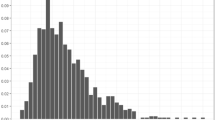Abstract
We consider a model of interacting neurons where the membrane potentials of the neurons are described by a multidimensional piecewise deterministic Markov process with values in \({\mathbb {R}}^N, \) where N is the number of neurons in the network. A deterministic drift attracts each neuron’s membrane potential to an equilibrium potential m. When a neuron jumps, its membrane potential is reset to a resting potential, here 0, while the other neurons receive an additional amount of potential \(\frac{1}{N}.\) We are interested in the estimation of the jump (or spiking) rate of a single neuron based on an observation of the membrane potentials of the N neurons up to time t. We study a Nadaraya–Watson type kernel estimator for the jump rate and establish its rate of convergence in \(L^2 .\) This rate of convergence is shown to be optimal for a given Hölder class of jump rate functions. We also obtain a central limit theorem for the error of estimation. The main probabilistic tools are the uniform ergodicity of the process and a fine study of the invariant measure of a single neuron.




Similar content being viewed by others
Notes
A short remark concerning the continuous time observation scheme : Presumably, if we deal with discrete time samples, observed at sufficiently high frequency such that with huge probability at most one jump can take place during one sampling step, it would be possible to reconstruct the continuous trajectory of the process with hight probability and to perform our estimation procedure also in this frame.
References
Azaïs R, Bardet JB, Genadot A, Krell N, Zitt P-A (2014) Piecewise deterministic Markov process (pdmps). Recent results. ESAIM: Proceedings 44:276–290
Azaïs R, Dufour F, Gégout-Petit A (2014) Nonparametric estimation of the conditional distribution of the inter-jumping times for piecewise-deterministic Markov processes. Scandinavian Journal of Statistics 41(4):950–969
Azaïs R, Muller-Gueudin A (2015) Optimal choice among a class of nonparametric estimators of the jump rate for piecewise-deterministic Markov processes. Available on arxiv:1506.07722
Azéma J, Duflo M, Revuz D (1969) Mesures invariantes des processus de Markov récurrents. Sém. Proba III, Lectures Notes in Math. 88, 24-33, Springer Verlag: Berlin
Bowman AW (1984) An alternative method of cross-validation for the smoothing of density estimates. Biometrika 71(2):353–360
Brémaud P, Massoulié L (1996) Stability of nonlinear Hawkes processes. The Annals of Probability 24(3):1563–1588
Crudu A, Debussche A, Muller A, Radulescu O (2012) Convergence of stochastic gene networks to hybrid piecewise deterministic processes. The Annals of Applied Probability 22:1822–1859
Davis MHA (1984) Piecewise-derministic Markov processes: a general class off nondiffusion stochastic models. J. Roy. Statist. Soc. Ser. B 46(3):353–388
Davis MHA (1993) Markov models and optimization. Monographs on Statistics and Applied Probability, vol. 49 Chapman & Hall, London
Duarte A, Ost G (2014) A model for neural activity in the absence of external stimuli. To appear in Markov Proc. Rel. Fields, available on arxiv:1410.6086
Duarte A, Galves A, Löcherbach E, Ost G (2016) Estimating the interaction graph of stochastic neural dynamics. Available on arxiv:1604.00419
Galves A, Löcherbach E (2013) Infinite systems of interacting chains with memory of variable length-a stochastic model for biological neural nets. J. Stat. Phys. 151(5):896–921
Galves A, Löcherbach E (2016) Modelling networks of spiking neurons as interacting processes with memory of variable length. Journal de la Société Française de Statistiques 157:17–32
Hall P, Marron JS, Park BU (1992) Smoothed cross-validation. Probab. Theory Related Fields 92(1):1–20
Hansen N, Reynaud-Bouret P, Rivoirard V (2015) Lasso and probabilistic inequalities for multivariate point processes. Bernoulli 21(1):83–143
Hodara P, Löcherbach E Hawkes, processes with variable length memory and an infinite number of components. (2014) To appear in Adv. Appl. Probab. 49:2017
Hoffmann M, Höpfner R, Löcherbach E (2002) Non-parametric estimation of the death rate in branching diffusions. Scand. J. Statistics 29(4):665–692
Hoffmann M, Olivier A (2015) Nonparametric estimation of the division rate of an age dependent branching process. To appear in Stochastic Processes and their Applications see also arxiv:1412.5936
Höpfner R, Löcherbach E (2003) Limit theorems for null recurrent Markov processes. Memoirs of the AMS
Ikeda N, Watanabe S (1981) Stochastic differential equations and diffusion processes. North-Holland Mathematical Library 24 Periodical. Elsevier, Academic Press City
Izhikevich E (2009) Dynamical systems in neuroscience: the geometry of excitability and bursting. MIT Press,
Jacod J (1979) Calcul stochastique et problèmes de martingales. Lecture Notes in Mathematics, 714, Springer
Jacod J, Shiryaev AN (1987) Limit theorems for stochastic processes. Springer-Verlag, Berlin
Krell N (2016) Statistical estimation of jump rates for a specific class of Piecewise Deterministic Markov Processes. ESAIM:PS. 20, 196–216
Löcherbach E (2002) Likelihood ratio processes for Markovian particle systems with killing and jumps. Statist. Inf. Stoch. Proc. 5:153–177
Löcherbach E (2015) Ergodicity and speed of convergence to equilibrium for diffusion processes. Unpublished note, available on http://eloecherbach.u-cergy.fr/cours.pdf
Löcherbach E (2016) Absolute continuity of the invariant measure in Piecewise Deterministic Markov Processes having degenerate jumps. Available on arxiv:1601.07123
Pakdaman K, Thieullen M, Wainrib G (2010) Fluid limit theorems for stochastic hybrid systems with application to neuron models. Adv. Appl. Probab. 42:761–794
Rudemo M (1982) Empirical choice of histograms and kernel density estimators. Scand. J. Statist. 9(2):65–78
Acknowledgements
We thank an anonymous referee for helpful comments and suggestions. This research has been conducted as part of the project Labex MME-DII (ANR11-LBX-0023-01), as part of the Agence Nationale de la Recherche PIECE 12-JS01-0006-01 and as part of the activities of FAPESP Research, Dissemination and Innovation Center for Neuromathematics (Grant 2013/07699-0, S. Paulo Research Foundation).
Author information
Authors and Affiliations
Corresponding author
Rights and permissions
About this article
Cite this article
Hodara, P., Krell, N. & Löcherbach, E. Non-parametric estimation of the spiking rate in systems of interacting neurons. Stat Inference Stoch Process 21, 81–111 (2018). https://doi.org/10.1007/s11203-016-9150-4
Received:
Accepted:
Published:
Issue Date:
DOI: https://doi.org/10.1007/s11203-016-9150-4
Keywords
- Piecewise deterministic Markov processes
- Kernel estimation
- Nonparametric estimation
- Biological neural nets




